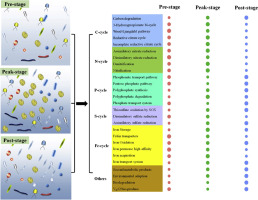当前位置:
X-MOL 学术
›
Water Res.
›
论文详情
Our official English website, www.x-mol.net, welcomes your feedback! (Note: you will need to create a separate account there.)
Functional profiles of phycospheric microorganisms during a marine dinoflagellate bloom.
Water Research ( IF 12.8 ) Pub Date : 2020-01-28 , DOI: 10.1016/j.watres.2020.115554 Jin Zhou 1 , Bo-Ya Zhang 2 , Ke Yu 2 , Xiao-Peng Du 1 , Jian-Ming Zhu 1 , Yan-Hua Zeng 1 , Zhong-Hua Cai 1
Water Research ( IF 12.8 ) Pub Date : 2020-01-28 , DOI: 10.1016/j.watres.2020.115554 Jin Zhou 1 , Bo-Ya Zhang 2 , Ke Yu 2 , Xiao-Peng Du 1 , Jian-Ming Zhu 1 , Yan-Hua Zeng 1 , Zhong-Hua Cai 1
Affiliation

|
Harmful algal blooms (HABs) are an ecological concern but relatively few studies have investigated the functional potential of bacterioplankton over a complete algal bloom cycle, which is critical for determining their contribution to the fate of algal blooms. To address this point, we carried out a time-series metagenomic analysis of the functional features of microbial communities at three different Gymnodinium catenatum bloom stages (pre-, peak-, and post-bloom). Different microbial composition were observed during the blooming stages. The environmental parameters and correlation networks co-contribute to microbial variability, and the former explained 38.4% of total variations of the bacterioplankton community composition. Functionally, a range of pathways involved in carbon, nitrogen, phosphorus and sulfur cycling were significantly different during the various HAB stages. Genes associated with carbohydrate-active enzymes, denitrification, and iron oxidation were enriched at the pre-bloom stage; genes involved in reductive citrate cycle for carbon fixation, carbon degradation, nitrification and phosphate transport were enhanced at the peak stage; and relative gene abundance related to sulfur oxidation, vitamin synthesis, and iron transport and storage was increased at the post-bloom stage. The ecological linkage analysis has shown that microbial functional potential especially the C/P/Fe metabolism were significantly linked to the fate of the algal blooms. Taken together, our results demonstrated that microorganisms displayed successional patterns not only at the community level, but also in the metabolic potential on HAB's progression. This work contributes to a growing understanding of microbial structural elasticity and functional plasticity and shed light on the potential mechanisms of microbial-mediated HAB trajectory.
中文翻译:

海洋藻鞭毛藻开花期间,藻圈微生物的功能概况。
有害藻华(HABs)是一个生态问题,但相对较少的研究已经研究了浮游细菌在整个藻华循环中的功能潜力,这对于确定其对藻华命运的贡献至关重要。为了解决这一问题,我们对三个不同的裸藻(Gymnodinium catenatum)开花阶段(花前,花后和花后)的微生物群落功能特征进行了时间序列宏基因组学分析。在开花阶段观察到不同的微生物组成。环境参数和相关网络共同促进了微生物的变异性,前者解释了浮游生物群落组成总变异的38.4%。从功能上讲,涉及碳,氮,在HAB的各个阶段,磷和硫的循环显着不同。与糖活性酶,反硝化作用和铁氧化有关的基因在开花前富集。在高峰期,参与还原柠檬酸盐循环的碳固定,碳降解,硝化和磷酸盐转运的基因得到增强;在开花后阶段,与硫氧化,维生素合成以及铁运输和储存有关的相对基因丰度增加了。生态联系分析表明,微生物功能潜能,特别是C / P / Fe代谢与藻华的命运有显着联系。综上所述,我们的结果表明,微生物不仅在群落水平上,而且在HAB'上的代谢潜能上都显示出连续的模式。的进步。这项工作有助于人们对微生物的结构弹性和功能可塑性的深入了解,并阐明微生物介导的HAB轨迹的潜在机制。
更新日期:2020-01-29
中文翻译:

海洋藻鞭毛藻开花期间,藻圈微生物的功能概况。
有害藻华(HABs)是一个生态问题,但相对较少的研究已经研究了浮游细菌在整个藻华循环中的功能潜力,这对于确定其对藻华命运的贡献至关重要。为了解决这一问题,我们对三个不同的裸藻(Gymnodinium catenatum)开花阶段(花前,花后和花后)的微生物群落功能特征进行了时间序列宏基因组学分析。在开花阶段观察到不同的微生物组成。环境参数和相关网络共同促进了微生物的变异性,前者解释了浮游生物群落组成总变异的38.4%。从功能上讲,涉及碳,氮,在HAB的各个阶段,磷和硫的循环显着不同。与糖活性酶,反硝化作用和铁氧化有关的基因在开花前富集。在高峰期,参与还原柠檬酸盐循环的碳固定,碳降解,硝化和磷酸盐转运的基因得到增强;在开花后阶段,与硫氧化,维生素合成以及铁运输和储存有关的相对基因丰度增加了。生态联系分析表明,微生物功能潜能,特别是C / P / Fe代谢与藻华的命运有显着联系。综上所述,我们的结果表明,微生物不仅在群落水平上,而且在HAB'上的代谢潜能上都显示出连续的模式。的进步。这项工作有助于人们对微生物的结构弹性和功能可塑性的深入了解,并阐明微生物介导的HAB轨迹的潜在机制。

























 京公网安备 11010802027423号
京公网安备 11010802027423号